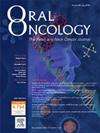新辅助化疗联合抗pd -1单克隆抗体治疗局部晚期可切除口腔鳞状细胞癌的疗效评价及预测
IF 3.9
2区 医学
Q1 DENTISTRY, ORAL SURGERY & MEDICINE
引用次数: 0
摘要
背景:新辅助化疗(NAC)联合抗pd -1抗体治疗是可切除口腔鳞状细胞癌(OSCC)的潜在治疗选择。识别生物标志物以预测治疗效果对于优化该方案仍然至关重要。方法30例局部晚期、可切除的OSCC (T3-T4, N0-N2, M0)患者接受紫杉醇(175 mg/m2)、顺铂(75 mg/m2) +抗pd -1单克隆抗体辛替单抗(200 mg)组成的2个周期新辅助化疗免疫治疗(NACI),进行单组II期临床试验。25例患者接受手术切除,5例接受非手术治疗。主要终点为病理反应,次要终点为临床反应。对预处理活检样本进行人工智能核分割分类,绘制炎症细胞浸润的空间图。采用转录组RNA测序(RNA-seq)分析和免疫组化(IHC)方法鉴定有和无重大病理反应(MPR)患者之间差异表达的基因和免疫细胞亚型。结果25例行手术切除的患者MPR为44.0%。客观有效率(ORR)为53.3%。原发肿瘤部位与病理反应显著相关(P < 0.05)。虽然AI分析显示各组间总体炎症细胞浸润无显著差异,但RNA-seq数据的免疫浸润分析显示,MPR组与非MPR组间M1-和m2型巨噬细胞的比例存在显著差异。所有12例测序患者的CD86免疫组化验证证实,MPR肿瘤中M1浸润显著升高(13.75%对4.5% CD86+细胞,P < 0.001),直接将M1极化与PD-1抑制的治疗敏感性联系起来。结论snac联合抗pd -1抗体治疗OSCC具有临床意义,且毒性可控。通过RNA-seq和免疫组化验证,M1巨噬细胞浸润成为病理反应的一种新的预测性生物标志物,为肿瘤微环境中PD-1阻断效果的机制提供了见解。中国临床试验注册中心,ChiCTR2400091891。本文章由计算机程序翻译,如有差异,请以英文原文为准。
Neoadjuvant chemotherapy combined with anti-PD-1 monoclonal antibody in locally advanced resectable oral squamous cell carcinoma: efficacy evaluation and prediction
Background
Neoadjuvant chemotherapy (NAC) combined with anti-PD-1 antibody therapy is a potential treatment option for resectable oral squamous cell carcinoma (OSCC). Identifying biomarkers to predict therapeutic efficacy remains critical for optimizing this regimen.
Methods
Thirty patients with locally advanced, resectable OSCC (T3–T4, N0–N2, M0) who received two cycles of neoadjuvant chemoimmunotherapy (NACI) consisting of paclitaxel (175 mg/m2) and cisplatin (75 mg/m2) plus the anti-PD-1 monoclonal antibody sintilimab (200 mg) were enrolled in this single-arm phase II trial. Twenty-five patients underwent surgical resection and five received nonsurgical therapy. The primary and secondary end points were pathological response and clinical response, respectively. AI-powered nuclear segmentation and classification was applied to pre-treatment biopsy samples to spatially map inflammatory cell infiltration. Transcriptome RNA sequencing (RNA-seq) analysis and IHC were used to identify differentially expressed genes and immune cell subtypes between patients with and without major pathological response (MPR).
Results
The MPR rate was 44.0 % among the 25 patients who underwent surgical resection. The objective response rate (ORR) was 53.3 %. The primary tumor location significantly correlated with pathological response (P < 0.05). While AI analysis showed no significant difference in overall inflammatory cell infiltration between groups, immune infiltration analysis of the RNA-seq data revealed significant differences in the proportions of M1- and M2-type macrophages between the MPR and non-MPR groups. CD86 IHC validation across all 12 sequenced patients confirmed significantly elevated M1 infiltration in MPR tumors (13.75 % vs. 4.5 % CD86+ cells, P < 0.001), directly linking M1 polarization to therapeutic sensitivity to PD-1 inhibition.
Conclusions
NAC combined with anti-PD-1 antibody therapy demonstrates clinically meaningful efficacy in OSCC, accompanied by a manageable toxicity profile. M1 macrophage infiltration, validated by both RNA-seq and IHC, emerges as a novel predictive biomarker for pathological response, providing mechanistic insight into PD-1 blockade efficacy within the tumor microenvironment.
Trial registration
Chinese clinical trial registry, ChiCTR2400091891.
求助全文
通过发布文献求助,成功后即可免费获取论文全文。
去求助
来源期刊

Oral oncology
医学-牙科与口腔外科
CiteScore
8.70
自引率
10.40%
发文量
505
审稿时长
20 days
期刊介绍:
Oral Oncology is an international interdisciplinary journal which publishes high quality original research, clinical trials and review articles, editorials, and commentaries relating to the etiopathogenesis, epidemiology, prevention, clinical features, diagnosis, treatment and management of patients with neoplasms in the head and neck.
Oral Oncology is of interest to head and neck surgeons, radiation and medical oncologists, maxillo-facial surgeons, oto-rhino-laryngologists, plastic surgeons, pathologists, scientists, oral medical specialists, special care dentists, dental care professionals, general dental practitioners, public health physicians, palliative care physicians, nurses, radiologists, radiographers, dieticians, occupational therapists, speech and language therapists, nutritionists, clinical and health psychologists and counselors, professionals in end of life care, as well as others interested in these fields.
 求助内容:
求助内容: 应助结果提醒方式:
应助结果提醒方式:


